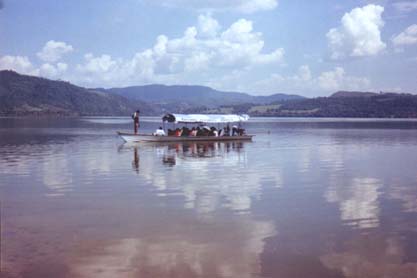|









|


PERU
El Perú, situated on the west coast of South America, is a
country of great mysteries, ancient cultures and wonderful geography.
General Facts
Official Name: Republic of Perú
Area:
496,222 sq. miles
Population: 24 million (approximate)
Administrative Division: 12 Regions, 24 Departments and one
Constitutional Province (El Callao)
Capital: City of Lima
Other Cities: Arequipa, Cuzco, El Callao, Iquitos,
Trujillo
Languages: Spanish and Quechua (official languages),
Aymará and amazon dialects
Literacy: 87.2%
National
Holiday: July 28 - Independence Day
Other Facts
- Perú, name origin
- The Spanish conquistadors arrived to the Kingdom of
Virú, which was part of the Tahuantinsuyo or Empire of the Incas, in
1530. When they asked the natives about the name of their land, they were told,
"Virú", but they understood "Pirú". Every land that they
conquered, was given that name: Pirú. As time passed, the name changed
to Perú.
- Cebiche, national dish
- Cebiche is the national dish of Perú. It is prepared
with fresh fish cooked in lemon and condimented with salt, pepper and garlic.
Also added is, rocoto (a hot pepper from Perú) and sliced onions.
Cebiche originated in colonial times. Peruvian fishermen were used to dice cut
fish and used them as bait or cebo (spanish for bait), in order to catch more
fish. When they were hungry while waiting for the catch, they added salt and
lemon to the dice cut fish and ate them. As years passed the practice became
more popular and a new dish was created. The Cebiche is almost the same as a
few centuries ago but in the second half of last century, the seafood (shrimp,
squid, octopus and more) cebiche became popular. The preparation of cebiche has
extended to other latinamerican countries but it is the Peruvian Cebiche the
most internationally known and the most delicious.
- Pisco Sour, national drink
- Pisco Sour is the national drink of Perú. It is
prepared with the Pisco brandy, lime juice, sugar, egg and crushed ice. Pisco
Sour became very popular in the 1870 decade in the United States as the Pisco
Punch. Origin of the word Pisco. The Incas called Pishco
(bird in their quechua language) the site where the actual Port of Pisco is
situated, due to the great variety of local birds they found when they
conquered that land. Pisco is situated in the department of Ica. Pisco
brandy origin. The department of Ica in Perú is where the Nazca and
Paracas cultures flourished. The natives were excellent agriculturists and also
were famous for preparing "chicha", a fermented drink made of maize.
When the Spanish conquerors settled on this land, they brought many produces to
cultivate, one of them were, grapes. Due to the great quality of the land and
good climate, grapes from the Ica's valleys became well known. The Spanish also
produce a brandy from these grapes, "it took the name of Pisco because of the
port where it was shipped" (Fray Reginaldo de Lizárraga, XVI century).
The Pisco today. The Pisco is processed with the Quebranta grape variety
which only grows in Perú and the reason the peruvian Pisco is different
from other types of brandy. The Pisco and Pisco Sour are known all over the
world as one of the many contributions of Perú to the international
gourmet.
- Potato: Peru's gift to the world
- The potato is a native plant from the Andes. The ancient
peruvians discovered it as a wild plant. It is unknown how they made it eatable
but it was cultivated for many centuries before the Incas. Numerous tubers have
been found in precolumbian tombs. The Incas learned how to cultivate potatos
and taught other andean people that they conquered. Soon, it became the basic
food of the andean population. The potato to the world. The spanish
conquistadors that arrived in Perú called it: "native's bread". The
conquistadors took it to Spain and made it known to the rest of Europe. The
europeans then took it to other continents. The potato in actual times.
The potato in our times is one of the most important foods in the world. Peru
is the country with the widest variety of the plant. In Peru functions the
International Potato Institute, organism dedicated to the scientific study of
the plant.

PERU
Picture of the Month
(December
2004)
The Blue Lagoon - El Sauce (San Martín)

November: Plaza Mayor
- Moyobamba
October: Pomacocha
Lake - Florida (Amazonas)
September:
Plaza Mayor - Puerto Maldonado
August: The
Cathedral - Chachapoyas
July: José A.
Quiñones Square: Pimentel
June: Pre-Inca Temple of
Kotosh - Huánuco
May: The Cathedral
- Huancavelica
April: City Hall -
Trujillo
March: Plaza de Armas and
Virgen del Rosario Church - Jauja (Junín)
February: La Merced
Church - Juliaca (Puno)
January: Shipibo
Village of San Francisco - Ucayali


Peruvian National Anthem midi, courtesy of:
El Rincón Musical Peruano

©NJPerú. 2000-2004. All Rights
Reserved. |